How Do You Paint Clouds
Learning how to paint clouds requires practice and some imagination. I am not one who typically likes "how to" approaches to painting, as there never can truly be an exact step by step method when it comes to painting. Working with paint is a messy activity that involves working out problems. On the canvas this involves wiping out areas and repainting.
However, as painting is a visual language, I believe that it is exceedingly helpful to see something develop step by step. Therefore in this cloud painting tutorial, I have documented the progression of easy cloud painting techniques I use to paint clouds in oil.
Scroll to the end of this article to see the full cloud painting video tutorial!
Contents
- 1 Cloud Painting Compositions Covered in this Article
- 2 How to Paint Clouds – A Single Cloud in the Sky
- 2.1 Begin with how to start painting the sky
- 2.2 What colors to mix for sky painting portion
- 2.3 Begin to mix colors for your first cloud
- 2.4 Get a sense of light in your cloud painting from the beginning
- 2.5 How to paint clouds by adding shadows
- 2.5.1 Additional help for color mixing shadows
- 2.6 How to paint clouds and sky together at the same time
- 2.7 Pay attention to very light and subtle shadows
- 2.8 The completion of our singular cloud painting composition
- 3 How to Paint Clouds – Painting Multiple Clouds Together
- 3.1 How to sketch out your cloudy sky painting composition
- 3.2 How to paint clouds starting with a patch of blue sky
- 3.3 Establish a strong sense of light with first three colors
- 3.4 How to create soft edges in the cloud painting
- 3.5 How to paint clouds with subtle shadow colors
- 3.6 Adding darker shadows while painting clouds
- 3.7 Creating additional dark shadows along with warm lights
- 3.8 Subtle shadow tones and expanding the blue sky
- 3.9 How to paint small clouds in our cloudy sky painting
- 3.10 How to paint clouds with warm light shadows
- 3.11 Cloudy sky painting finishing touches
- 4 Paint Colors Used in this Cloud Painting Tutorial
- 5 How to Paint Clouds (Video Tutorial)
Cloud Painting Compositions Covered in this Article

First we will start learning how to paint clouds with a single cloud painting study. Then later on in this article, we will dive into learning how to paint multiple clouds together with a cloudy sky tutorial.
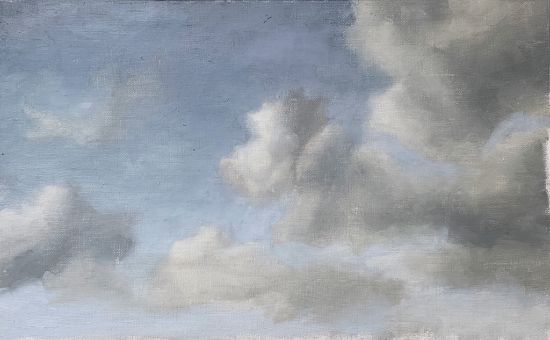
Let's get started!
How to Paint Clouds – A Single Cloud in the Sky

Begin with how to start painting the sky
The first step in learning how to paint clouds, starts with how to paint the sky. I start out painting the blue of the sky as this color is darker than the 'white' cloud and want to create a sense of contrast right from the start.
What colors to mix for sky painting portion
So, for mixing my blue I use ultramarine blue, cobalt blue and mix in a little cadmium orange to mute them. I then add in a little white to lighten the blue sky color I just mixed color. If I used the blues straight from the tube it would be much too dark and bright!
There are a few different things to learn when color mixing with oil paints, especially if it's relatively new to you.
Begin to mix colors for your first cloud
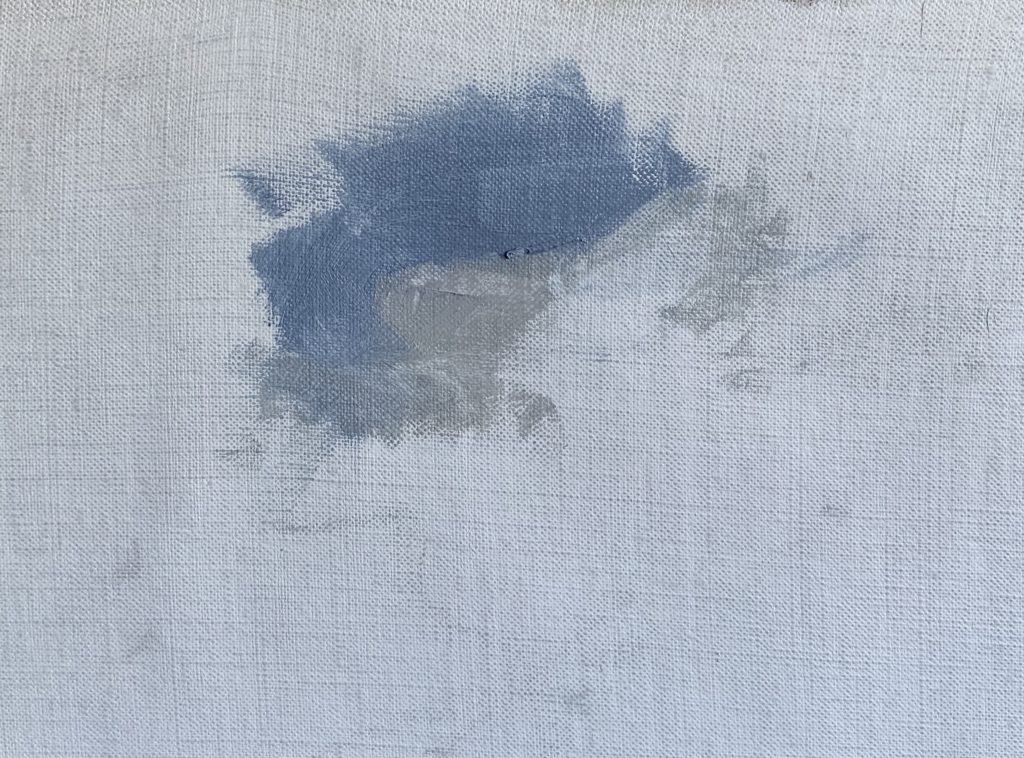
After starting with how to paint the sky by adding our blue color, as seen in the first image. I work towards mixing the 'cloud' color. Mixing cloud colors is tricky in learning how to paint clouds. As there are a lot of subtleties and minute shifts of tone and color when painting clouds in oil. One tip in particular, you will be working primarily with white, a little ultramarine blue, cobalt blue and cadmium orange.
So, take some white and mix in a very small amount of blue and equally small amount of cadmium orange. Mix these together to get a 'darker' white. Make sure that the white is not overly orange or blue. You want it to still look 'white', just not a bright white. We are reserving the bright white for later on in our cloud painting tutorial!
Get a sense of light in your cloud painting from the beginning
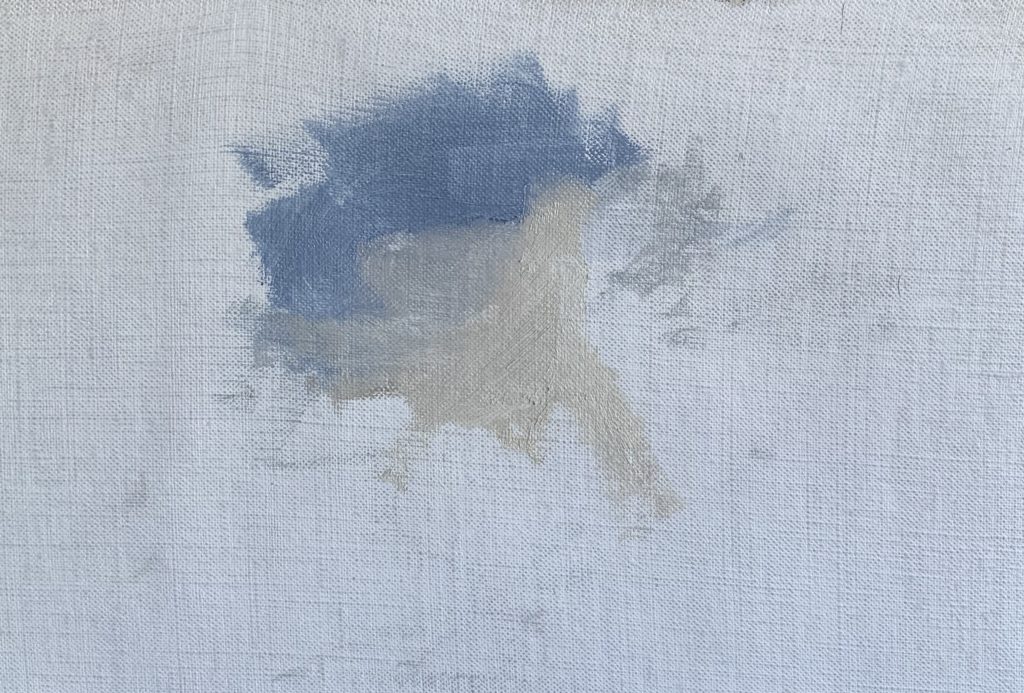
Mix a lighter white to put next to the 'darker' white of your cloud as seen in the images above. As before, start with some white and mix in a small amount of ultramarine blue. Then add some orange – but mix in a tiny bit more orange than before. We want this white to look warmer. If you want, you can also mix in a small amount of cadmium lemon to brighten it as I did.
You will then put another spot of 'white' next to this brightest white. Make this white slightly darker by adding a very small amount muted orange (blue + orange) to your previous color.
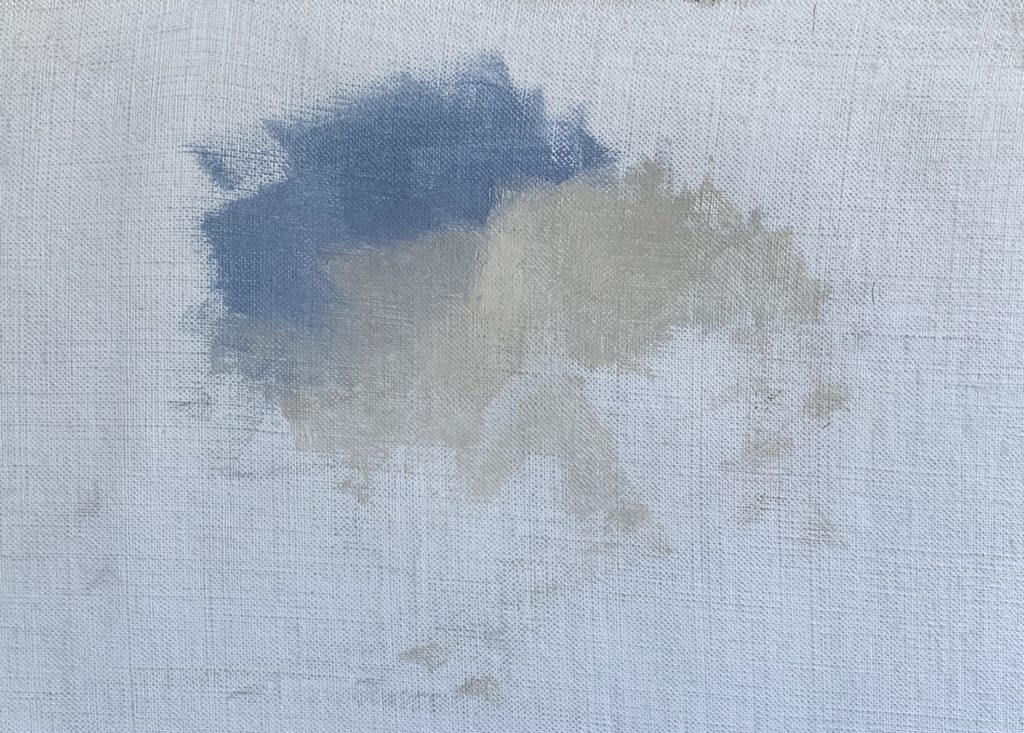
When working through how to paint clouds, it is important to get a sense of light from the beginning. Therefore, it is helpful to start with painting the sky first, then add the shadow area of the cloud and then the light area of the cloud. You will have a strong start to your cloud painting with this approach, as there will be a sense of light from the beginning.
How to paint clouds by adding shadows
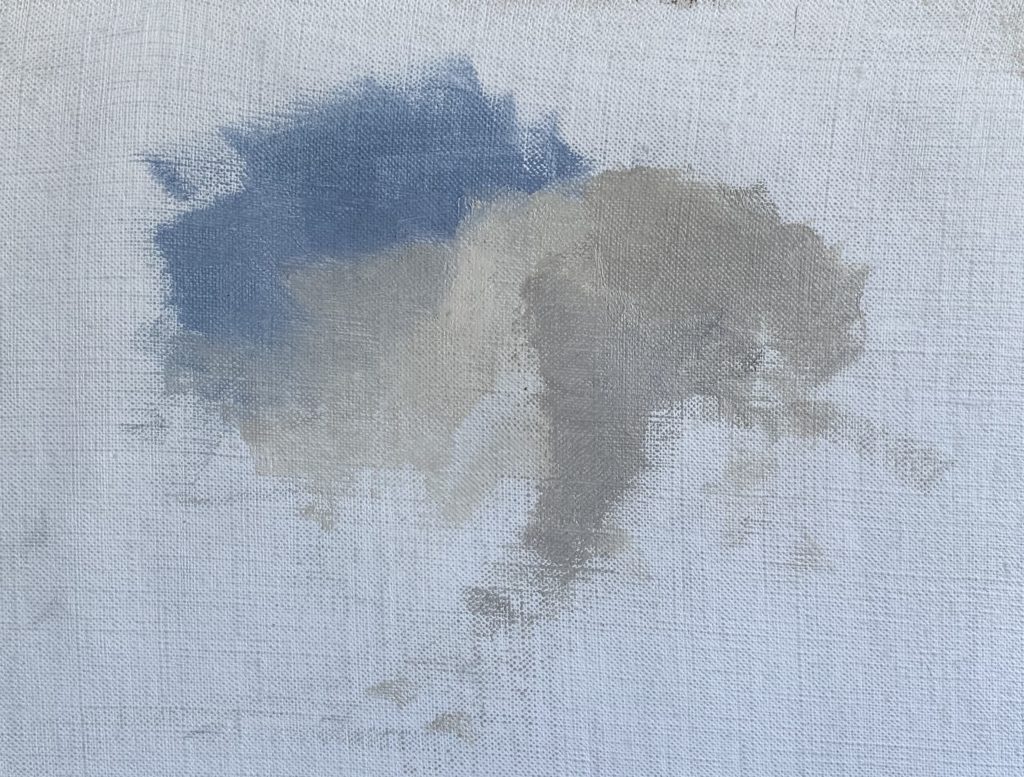
The lower part of a cloud is typically darker. It is important that you not make this shadow part too dark but also dark enough. It is difficult to balance this part as it so easily can be made too heavy/ dark – or too light! Start with some white, then add some ultramarine blue, then orange and mute the color so that it will be slightly darker than your other dark white cloud colors.
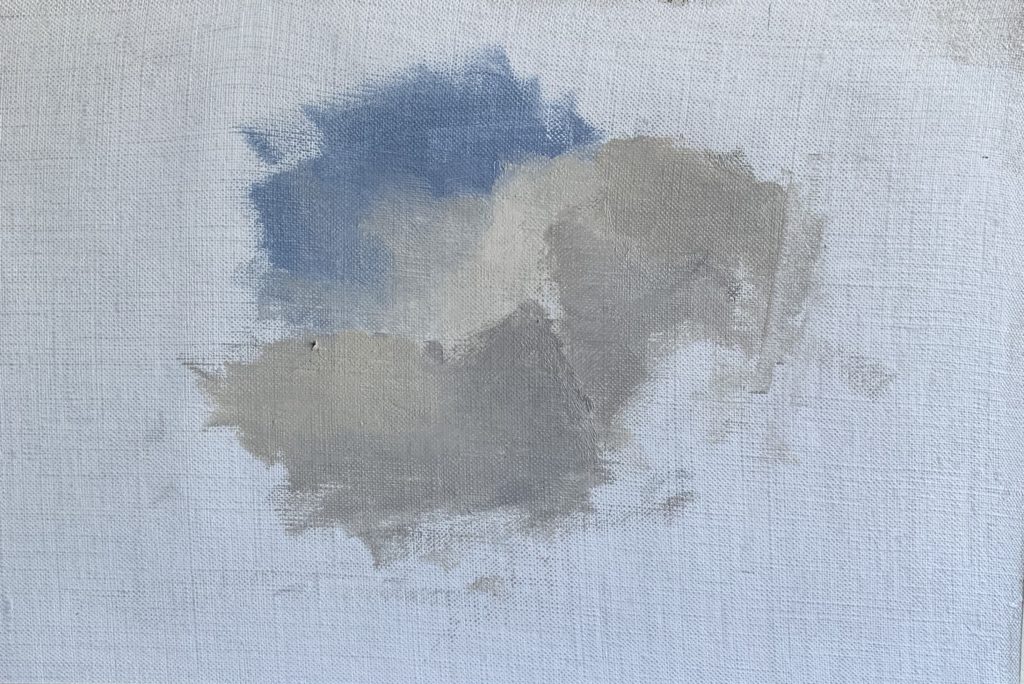
Additional help for color mixing shadows
You can receive and refer to my free color mixing guide for help with mixing the complementary colors, blue and orange (as well as purple and yellow) together. Which will be extremely helpful when it comes to mixing the 'shadow' areas in this easy cloud painting tutorial.

Vary the shadow area of your cloudy sky painting. Create a much lighter shadow on the upper area of the cloud while keeping the lower area of the cloud darker in value.

How to paint clouds and sky together at the same time

Continue to paint the sky and cloud together so that the cloud 'sits' well in the sky. You do not want to just paint the cloud by itself without also painting the sky in your cloud painting. It would then never feel like it is a cloud IN the sky.
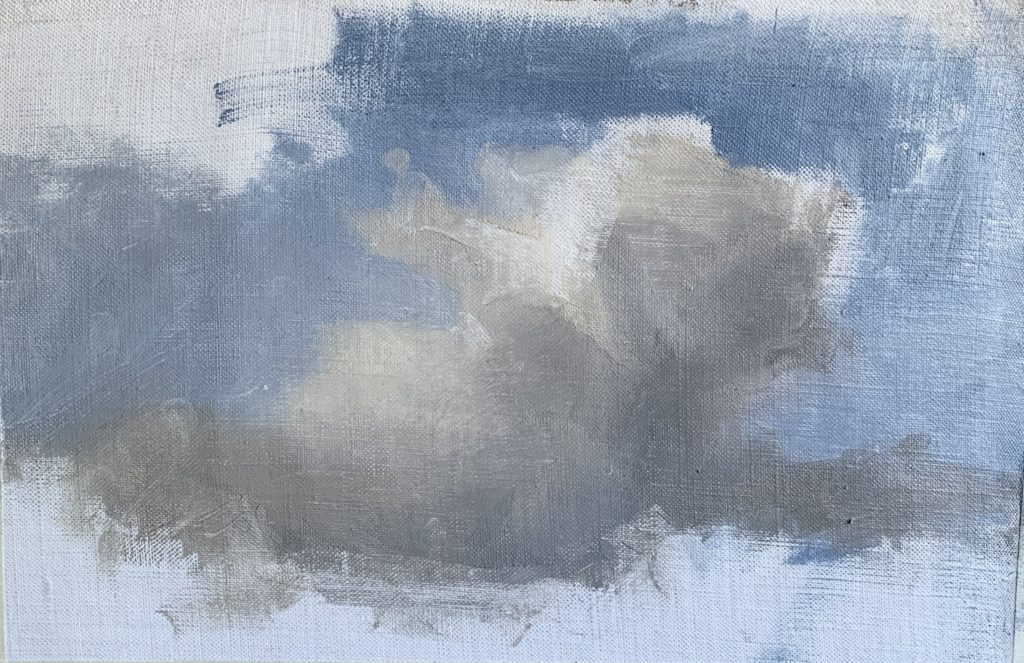
For the blue of the sky, mix together a combination of cobalt blue, ultramarine blue and some orange to mute the blues. Then, add in a little white. Generally the sky will be darker at the top of the cloud, then lighter as you move down the cloud. This is of course because the sky is receding away in space and things farther away appear lighter.

Continue to paint some extending shadowy cloud areas that are on the bottom area of the cloud. Try to make the bottom part of the cloud have softer edges. While the top part of the cloud should have slightly sharper edges.
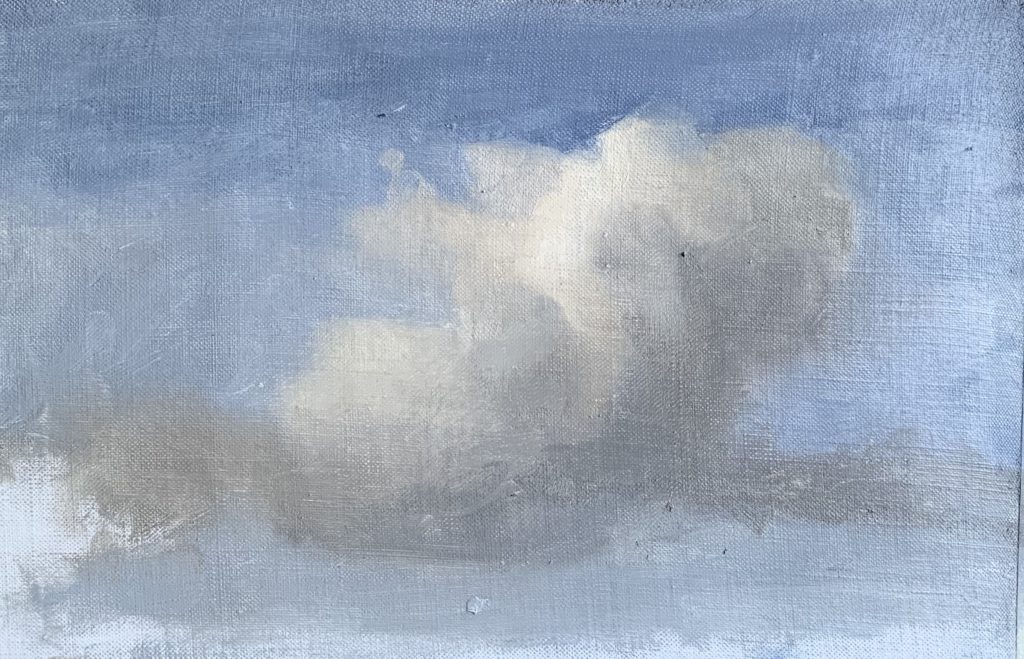
Pay attention to very light and subtle shadows
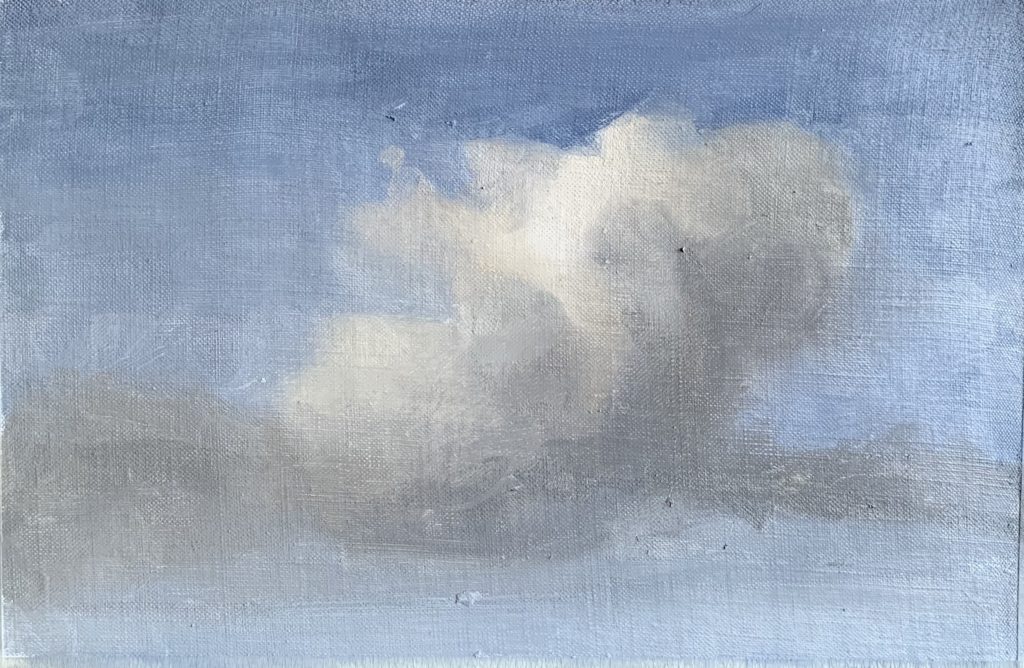
The shadow area that is next to the lightest part of the cloud was made lighter as it was too dark before. Here you can see a good example of the subtlety that is present in clouds. There are many tones that are very close in value.
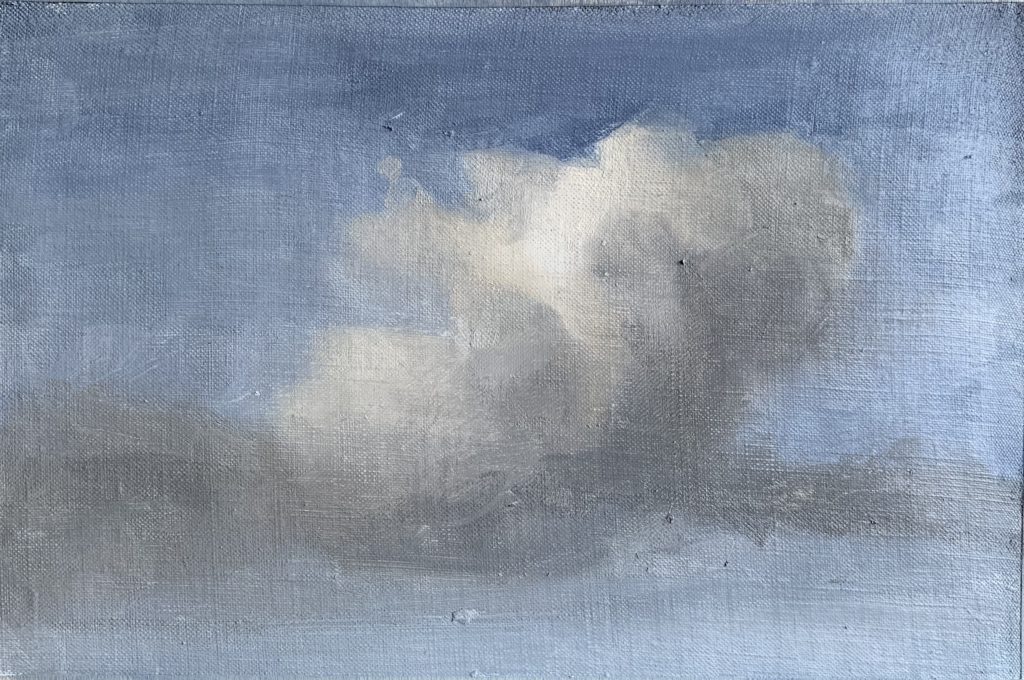
The completion of our singular cloud painting composition
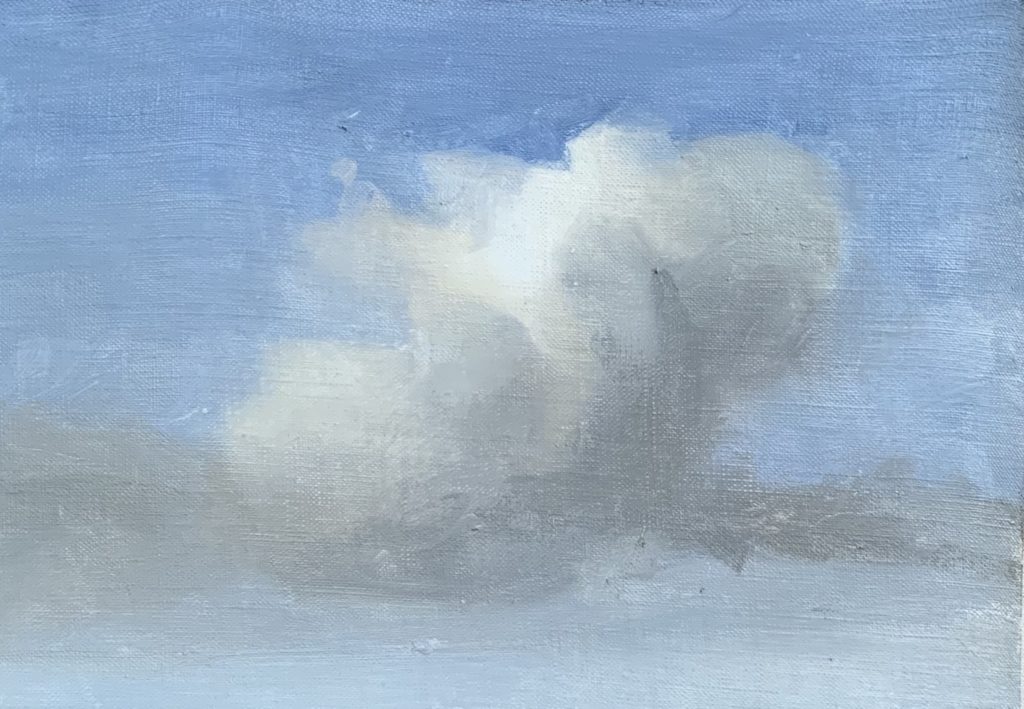
The complete finished painting (photographed in better lighting than the previous images!).
Clouds are very fun to paint as there is no set structure to them and they take on an infinite variety of forms. When practicing how to paint clouds and even working on painting realistic clouds. You can make them up! In fact, you more or less have to make them up even when plein air painting, as clouds change form so quickly.
Now that you have your singular cloud painting under your belt. You are ready to create a full on, cloudy sky painting with multiple clouds in place. Which you can find the tutorial directly below!
How to Paint Clouds – Painting Multiple Clouds Together
In the above tutorial you learned about what goes into creating a single cloud painting. Now, I will go over how to create a cloudy sky painting with multiple clouds!
How to sketch out your cloudy sky painting composition
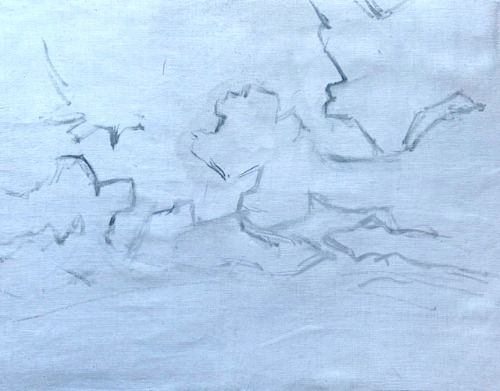
As always, it is important to sketch out your painting before starting. You want to capture the basic composition of your piece.
Here I put down the essential areas where I plan to put down my clouds. I keep it open in case I need to change an area down the road as I progress with the painting.
How to paint clouds starting with a patch of blue sky
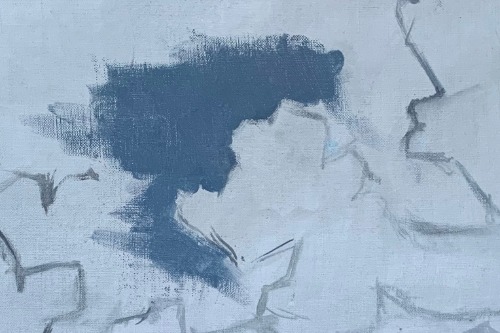
First off, I look at how to paint the sky by painting in some blue color to represent the blue sky of my cloud painting. I chose to start close to the center of the painting and mixed ultramarine blue and cobalt blue with some cadmium orange before lightening the color with some white.
Establish a strong sense of light with first three colors
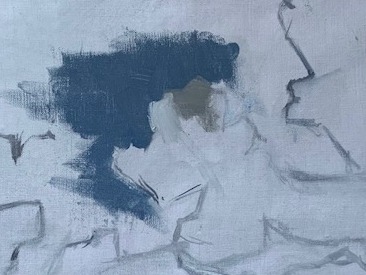
It is best for your first three colors to be an intersection of light and dark. This might sound a little confusing!
As an example look at the image above – the blue of the sky represents the 'dark value' color, the shadow area on the cloud the 'medium value' color and finally the spot of white paint next to the shadow area the 'light value' color
I mixed the shadow color on the cloud by mixing ultramarine blue with cadmium orange and then adding a little bit of white to the mix. For my light value color I added in a very (very small!!) small amount of ultramarine blue and cadmium orange.
How to create soft edges in the cloud painting

I use my finger to create a soft edge between my light value color and shadow color. Creating a soft edge between these two colors creates for a much smoother transition. Learning how to paint clouds is all about creating soft edges!
How to paint clouds with subtle shadow colors
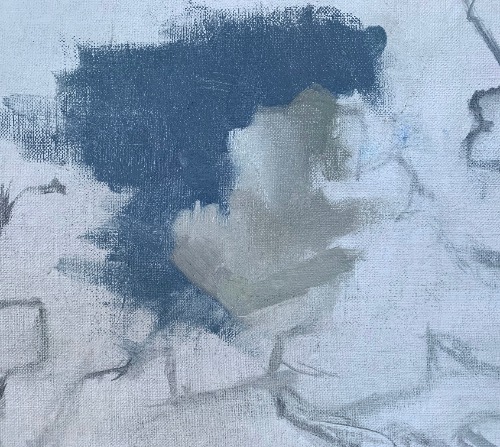
Next I add in some subtle shadows in the clouds. Being able to mix subtle shadow colors is key when it comes to painting clouds! Clouds are all about minute tonal changes. If you ever take a close look up at clouds you will see what I mean.
Of course, stormy clouds will have much darker shadows than those you will see on a sunny day. However, the changes are still subtle regardless of the weather situation.
For the shadows in the above image I mixed blue with orange. For some shadow colors I would have more orange mixed in, and others less. Then to lighten the shadow colors I would add varying amounts of white.
Adding darker shadows while painting clouds
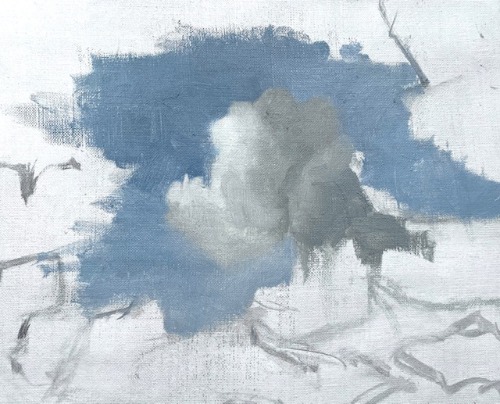
I create darker shadows for the upper 'body' of the cloud. To get it to be darker I do not mix in as much white to my ultramarine blue/ cadmium orange mixture. Notice the difference in value between the dark shadow on the top of the cloud to the much lighter shadows at the front of the cloud.
I also expand on the blue sky of the cloudy sky painting! The upper part of the sky is darker while the lower part of the sky is lighter.
Creating additional dark shadows along with warm lights
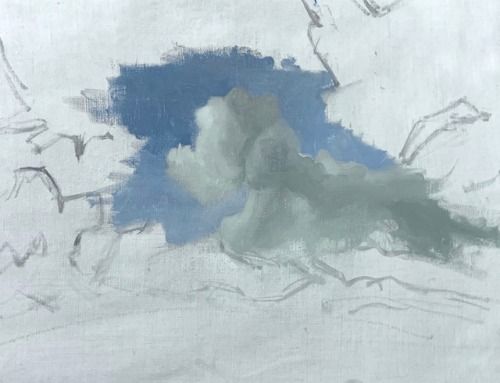
I expand my cloud area with shadows. In addition to painting in shadows I also add in warm light areas in the shadow.
Just like it is important to create subtle tonal changes in your shadows – the same is true for the 'light value' colors. I mix some lights that are not just slightly darker but also mix some lights that are 'warmer'.
To create just slightly darker 'lights' I mix in a small amount of blue/ cadmium orange mixture to my white. To make my white 'warmer' I mix in some cadmium orange and or yellow!
Subtle shadow tones and expanding the blue sky
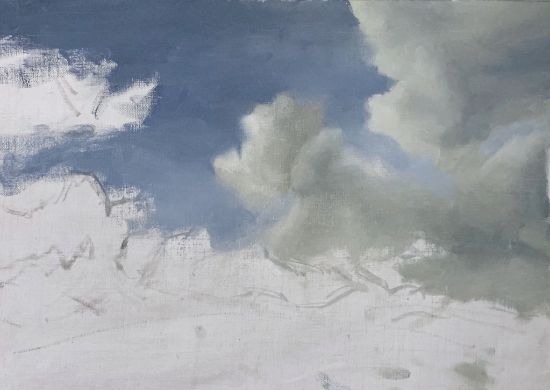
The composition is expanded by a large cloud being painted in the upper right hand corner. I painted a dark shadow and painted lighter more subtle shadow around the darker shadow.
I mixed a varying level of whites. Some whites are brighter while others are just very slightly darker. For the brightest area of whites I just mixed white with a small amount of cadmium yellow or cadmium orange.
How to paint small clouds in our cloudy sky painting
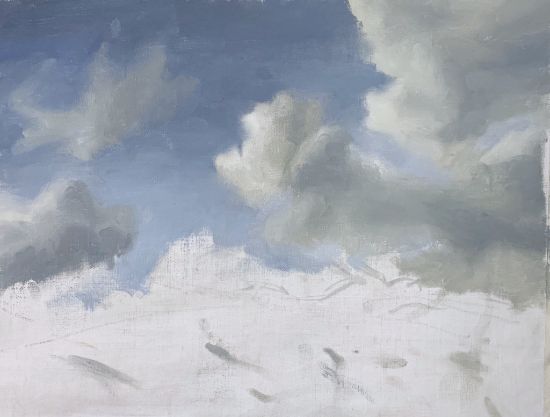
I create a small cloud in the upper left area of the painting. The cloud is darker and does not have a bright area of white like the other two clouds on the right. This is because I wanted it to sit back further in space.
If there had been a bright area painted out then it would have felt further forward in space.
There is another small cloud on the left beneath the cloud on the upper left. I created a darker shadow on the bottom part of the cloud – while the upper area of the cloud is lighter.
How to paint clouds with warm light shadows

Next in our cloudy sky painting, I paint a warm light cloud on the lower middle area of the painting. It is has very subtle shadows on the lower part of the cloud. While the upper part of the cloud is made up of a light value color.
I create a very soft and fluid transition between the upper light area of the cloud and the darker part of the cloud by creating soft edges.
Cloudy sky painting finishing touches

In the cloudy sky painting I made sure that the upper part of the painting is dark blue while the lower area is a lighter blue. This is because the upper part of the sky is darker as it is 'closer' to us while the lower part of the sky is 'further' away from us. Lighter colors always feel further away while darker colors feel closer than lighter colors.
In both these how to paint clouds tutorials I used oil paints. Here is a guide on particular tips of how to paint clouds in watercolor. You also might be interested in learning how to paint a landscape. Or if you're not sure your painting is 'done', here are 5 questions to ask yourself before finishing a painting.
Paint Colors Used in this Cloud Painting Tutorial
Ultramarine Blue

Cadmium Orange
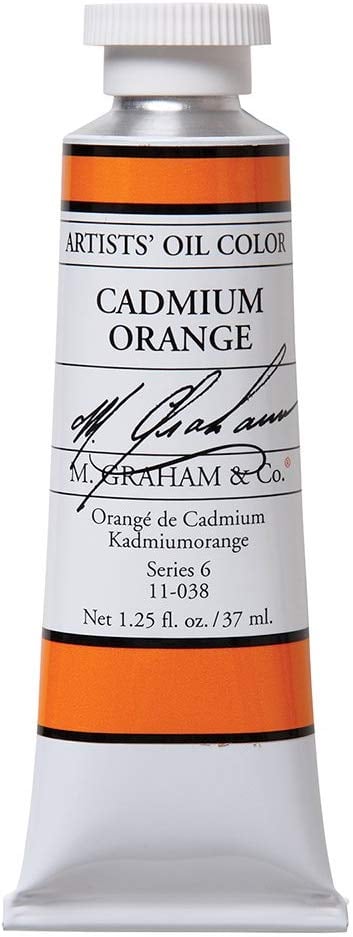
Cobalt Blue
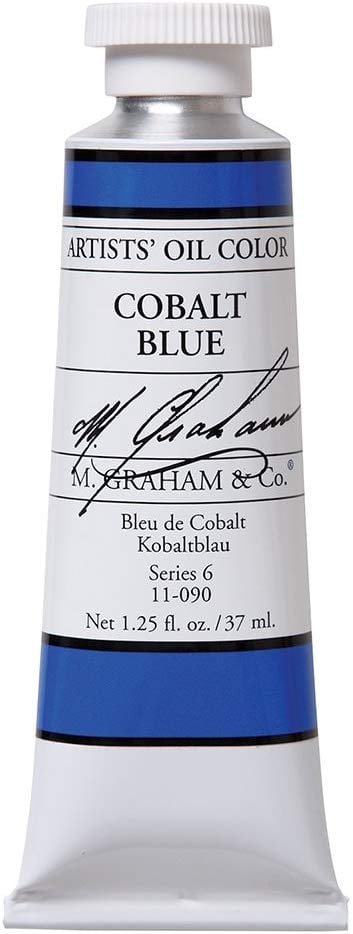
Titanium White

Cadmium Lemon
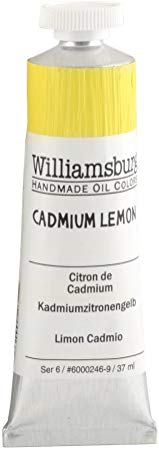
As always if you have any questions or thoughts, would love to hear from you in the comments below!
How to Paint Clouds (Video Tutorial)
Want to remember this? SaveHow to Paint Clouds to your favorite Pinterest board!


How Do You Paint Clouds
Source: https://artstudiolife.com/how-to-paint-clouds/
Posted by: flynncrue1941.blogspot.com

0 Response to "How Do You Paint Clouds"
Post a Comment